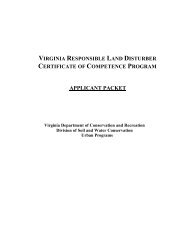Dameron Marsh NAP self-guided field trip guide - Virginia ...
Dameron Marsh NAP self-guided field trip guide - Virginia ...
Dameron Marsh NAP self-guided field trip guide - Virginia ...
You also want an ePaper? Increase the reach of your titles
YUMPU automatically turns print PDFs into web optimized ePapers that Google loves.
• Take a look over the railing of the deck.<br />
• Notice the raccoon prints in the mud. There may be other prints.<br />
• From here you have a good view of <strong>Marsh</strong> Elder and Camphor weed that has gone to seed.<br />
• If you turn around and look at the wax myrtle you are likely to see Yellow Rumped Warblers feasting on<br />
Wax Myrtle berries. You can see the yellow on their rump when they fly. A common name for this bird is<br />
“Butter Butt”.<br />
Stop 8<br />
Stop 9<br />
Stop 10<br />
• If you again look over the railing—you will see a handsome<br />
example of Salt Meadow Hay.<br />
• More tracks.<br />
• Look out into the distance to the shallow cove. You might<br />
spy some geese or swans. You might see 300 swans from this<br />
observation deck if you’re lucky.<br />
• Unfortunately, you might also see Mute Swans which are a<br />
non native bird species that competes with migrating tundra<br />
swans for food and nest areas, and devastate native submerged<br />
plants in the bay.<br />
• If you look straight ahead you may be able to distinguish<br />
some of the Phragmites australis that we have been spraying<br />
with a helicopter. Its hard to tell with everything all browned<br />
out but you might be able to see some white PVC stakes that<br />
I use for monitoring.<br />
• One of the reasons that <strong>Dameron</strong> <strong>Marsh</strong> is protected as a<br />
Natural Area Preserve ( the highest level of protection possible<br />
in <strong>Virginia</strong>) is because of the exemplary wetland community<br />
that you can see from here. There are many different<br />
zones of vegetation which are hard to see from here. The<br />
wetlands are mostly tidal and range from low to high marsh<br />
vegetation depending on slight variations in elevation and exposure<br />
to salt water.<br />
• The dominate grasses in the marsh are Black Needle Rush,<br />
Salt Meadow Hay and Salt Grass. For a nice view of salt<br />
grass peer over the railing—it is growing in stately lines from<br />
its rhizomes.<br />
• This is a nice view of all three of the rare or exemplary communities.<br />
• The sandy Northeastern Tiger Beetle beaches are just over the<br />
rise in the distance.<br />
• The vast marsh community is spread out before you all the<br />
land that you can see from here is part of <strong>Dameron</strong> <strong>Marsh</strong>.<br />
• The maritime loblolly pine forest is just to the north.
















